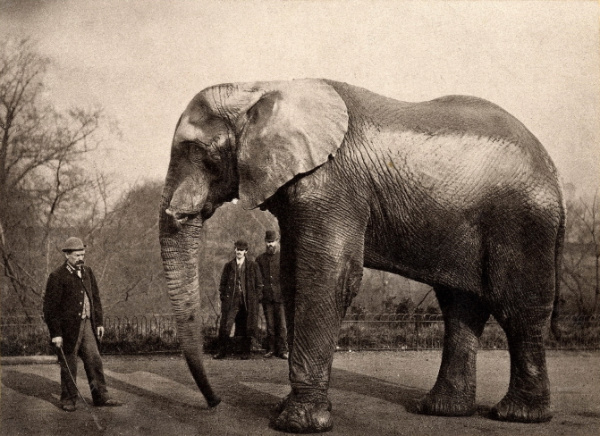
With his name a byword for things of a large size, Jumbo was an African bush elephant who was once one of London Zoo’s most popular residents (but whose life makes for sad reading).
Born in Sudan in about 1860, Jumbo – whose name is apparently a corruption of ‘jumbe’, the Swahili word for chieftain – was captured by hunters after his mother was killed and transported north to Europe. There he was apparently first exhibited in Germany before being sold to the Jardin des Plantes, a zoo in Paris.
In 1865, he was transferred to London Zoo in England where his keeper was Matthew Scott who went on to detail his care of Jumbo in his 1885 autobiography.
Jumbo quickly became a popular exhibit and was trained to give rides to children, including those of Queen Victoria (Teddy Roosevelt and Winston Churchill were apparently also among those who rode the elephant).
But out of public view, Jumbo, particularly as he matured, was growing increasingly destructive, smashing his den and breaking his tusks (it’s said Matthew Scott would pacify him with large quantities of alcohol).
In 1882, protests broke out when, apparently concerned over Jumbo’s growing aggression, then zoo superintendent Abraham Bartlett announced plans to sell Jumbo to American circus founder PT Barnum for £2,000. Some 100,000 school students wrote to Queen Victoria begging her to stop the transaction and a lawsuit was launched to stop the sale. It was unsuccessful.
Despite the protests, the sale went ahead and in March, 1882, Jumbo and Matthew Scott, who had decided to go with the elephant, went to America. In New York, Jumbo was exhibited at Madison Square Garden in a 31 week season. In 1884, he was one of 21 elephants who crossed the Brooklyn Bridge to prove it was safe following the death of 12 people during a collapse caused by a stampede few years earlier.

Jumbo died on 15th September, 1885, when he was hit by a train as he and other elephants were being led back to their boxcar. According to Barnum, Jumbo was attempting to lead a young elephant Tom Thumb to safety.
Following Jumbo’s death, a postmortem revealed his stomach contents included five English pennies, keys, rivets, and a police whistle.
Sadly, PT Barnum had the body parts separated for display before Jumbo’s skeleton was eventually donated to the American Museum of Natural History in New York City. The elephant’s heart was sold to Cornell University and its hide stuffed and eventually donated to Tufts University where it was destroyed in a fire in 1975 (Jumbo remains the university mascot).
There is a statue of Jumbo near where he died in St Thomas, Ontario, and a six-storey, elephant-shaped building in Margate City, New Jersey, which was built in 1881 is said to be inspired by him. He is also said to have inspired the Disney film, Dumbo.